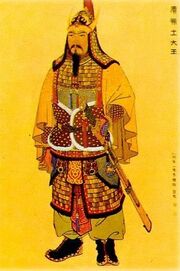
King Kwang Gae
Kwang-Gae is one of the three 1st degree black belt teul (forms) in ITF-style taekwondo. Kwang-Gae-Toh-Wang was the 19th King of the Koguryo Dynasty. He regained all the territories previously lost to the dynasty during prior conflicts, including the greater part of Manchuria. This form's diagram represents the expansion and recovery of lost territory. The 39 movements in the form refer to the first two digits of 391 C.E., the year Kwang came to the throne at age 17.
Kwang-Gae-Toh-Wang (374 C.E. - 413 C.E.) was renowned for his boldness and ambition during his youth. After he succeded his father to the throne, he undertook the task of regaining previously lost territories; through many conquests he expanded the territories of the Koguryo Dynasty. According to his tombstone, "64 castles and 1400 villages" were attacked and conquered during his reign.
His philosophy of expansion was inherited by his son, King Jang Soo Wang, the 20th Koguryo ruler. Jang Soo strengthened the army, invaded nearby nations and further expanded the Koguryo Dynasty, making it into a great empire.
Hanulson - Heaven Hands:[]
This form begins with a movement called Heaven Hands. Legend has it that King Kwang Gae stood upon a hill and gazed through his hands towards heaven, asking the gods for a quick and successful battle, When the enemy armies came over the horizon the king thrust his hands apart to signal the start of the battle.
Video[]
Why was this video chosen for use on this wiki? Do you have a better video? Please see Video Guidelines before replacing this video with a better one.
Diagram[]
Written Instructions[]

The lines of Kwang-Gae (student view)
Here on this wiki, the wording used to describe this form deviates from the conventional wording historically used to describe the form. This was done to facilitate wiki-style links to the names of associated techniques. To view the conventional wording, see ITF Forms Summary Description.
- Ready Posture: Parallel Stance with Heaven Hands
- 1. Bring the left foot to the right foot, forming a Closed Ready Stance Type B toward D, bringing both hands in a circular motion.
- 2. Step the left foot toward D into a Left Walking Stance facing D. Right Uppercut to D. Perform slowly.
- 3. Step the right foot toward D into a Right Walking Stance facing D. Left Uppercut to D. Perform slowly.
- 4. Step the left foot toward the side front of the right foot, and then step the right foot toward D, forming a Right Walking Stance facing D. Right High Hooking Palm Block to D. Perform in a double stepping motion.
- 5. Step the right foot toward C in a, sliding motion to form a Right L-Stance (i.e, left foot forward) facing D. Low Guarding Block to D.
- 6. Step the right foot toward the side front of the left foot and then step the left foot toward D, forming a Left Walking Stance facing D. Left High Hooking Palm Block to D. Perform in a double stepping motion.
- 7. Step the left foot toward C in a, sliding motion forming a Left L-Stance (i.e, right foot forward) facing D. Low Knifehand Guarding Block to D.
- 8. Step the left foot toward D, forming a Right Rear Foot Stance facing D. High Knifehand Guarding Block to D.
- 9. Step the right foot toward D, forming a Left Rear Foot Stance facing D. High Knifehand Guarding Block to D.
- 10. Step the left foot toward the side front of the right foot and then turn counter-clockwise, to form a Left Walking Stance facing C. Twin Palm Upward Block to C. Perform slowly.
- 11. Step the right foot toward C, forming a Right Walking Stance facing C. Left Upward Palm Block to C. Perform slowly.
- 12. Execute a Low Front Block in a circular motion, hitting the left palm, while bringing the left foot to the right foot to form a Closed Stance facing C.
- Perform 13 and 14 in a consecutive kick:
- 13. Execute a Left Pressing Kick to E, keeping the position of the hands as they were in 12.
- 14. Execute a Left Middle Side Piercing Kick to E, keeping the position of the hands as they were in 13.
- 15. Lower the left foot to E, forming a Right L-Stance (i.e, left foot forward) facing E. Right High Knifehand Inward Strike to E and bringing the left side fist in front of the right shoulder.
- 16. Execute a Left Downward Hammerfist Strike to E, while into a Closed Stance facing C, pulling the left foot to the right foot.
- Perform 17 and 18 in a consecutive kick:
- 17. Execute a Left Pressing Kick to F, keeping the position of the hands as they were in 16.
- 18. Execute a Right Middle Side Piercing Kick to F, keeping the position of the hands as they were in 17.
- 19. Lower the right foot to F, forming a Left L-Stance (i.e, right foot forward) facing F. High Knifehand Inward Strike to F and bringing the right side fist in front of the left shoulder.
- 20. Execute a Right Downward Hammerfist Strike to F, pulling the right foot to the left foot into a Closed Stance facing C.
- 21. Step the left foot toward C, forming a Left Low Stance facing C. Right Pressing Palm Block. Perform slowly.
- 22. Step the right foot toward C, forming a Right Low Stance facing C. Left Pressing Palm Block. Perform slowly.
- 23. Step the right foot toward D in a stomping motion to form a Sitting Stance facing F. Right High Backfist Side Strike to D.
- 24. Execute a Right Double Forearm Middle Block to D while forming a Right Walking Stance toward D, pivoting with the left foot.
- 25. Execute a Left Low Block to D, while shifting to C, maintaining a Right Walking Stance facing D, keeping the position of the right hand as it was in 24.
- 26. Execute a Right High Horizontal Fingertip Thrust (spearhand) to D, sliding the right foot toward D into a Right Low Stance facing D. Perform slowly.
- 27. Move the left foot on line CD in a stomping motion to form a Sitting Stance facing F. Left High Backfist Side Strike to C.
- 28. Execute a Left Double Forearm Middle Block to C while forming a Left Walking Stance toward C, pivoting with the left foot.
- 29. Execute a Right Low Reverse Block to C, while shifting to D, maintaining a Left Walking Stance facing C, keeping the position of the left hand as it was in 28.
- 30. Execute a left High Horizontal Fingertip Thrust (spearhand) to C, pulling the left foot toward C into a Left Low Stance facing C.
- 31. Step the right foot toward C in a stomping motion, forming a Right Walking Stance facing C. High Twin Fist Vertical Punch to C.
- 32. Step the left foot toward A in a stomping motion, forming a Left Walking Stance facing A. Left Uppercut to A.
- 33. Execute a middle Right Front Snap Kick to A, keeping the position of the hands as they were in 32.
- 34. Lower the right foot to the left foot, and then Step the left foot toward A to form a Left L-Stance (i.e, right foot forward) facing B. Middle Knifehand Guarding Block to B.
- 35. Step the left foot toward B, forming a Left Walking Stance facing B. Left High Punch to B.
- 36. Step the right foot toward B in stomping motion, forming a Right Walking Stance facing B. Twin Fist Uppercut to B.
- 37. Execute a middle Right Front Snap Kick to B with the left foot, keeping the position of the hands as they were in 36.
- 38. Lower the left foot to the right foot, then Step the right foot toward B to form a Right L-Stance (i.e, left foot forward) facing A. Middle Knifehand Guarding Block to A.
- 39. Step the right foot toward A, forming a Right Walking Stance facing A. Right High Punch to A.
- End: Bring the foot back to the ready position.
Black Belt Forms[]
The ITF-style Black Belt forms are:
- Kwang-Gae (39 movements) - 1st dan
- Po-Eun (36 movements) - 1st dan
- Ge-Baek (44 movements) - 1st dan
- Eui-Am (45 movements) - 2nd dan
- Choong-Jang (52 movements) - 2nd dan
- Juche (45 movements) - 2nd dan / Ko-Dang* (39 movements) - 2nd dan
- Sam-Il (33 movements) - 3rd dan
- Yoo-Sin (68 movements) - 3rd dan
- Choi-Yong (46 movements) - 3rd dan
- Yon-Gae (49 movements) - 4th dan
- Ul-Ji (42 movements) - 4th dan
- Moon-Moo (61 movements) - 4th dan
- So-San (72 movements) - 5th dan
- Se-Jong (24 movements) - 5th dan
- Tong-Il (56 movements) - 6th dan
Forms no longer used:
* Ko-Dang is an older form, replaced with Juche. Ko-Dang is still taught in some schools however.
U-Nam is an ITF/Chang Hon-style form that appears only in the 1959 edition of Choi Hong Hi's Tae Kwon Do Teaching Manual.
References[]
The primary reference is:
The following websites are also particularly good online references for ITF-style taekwondo:

